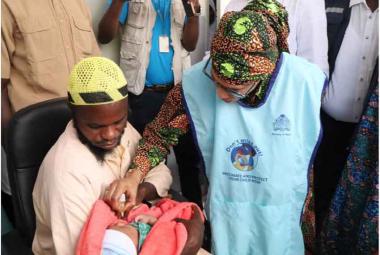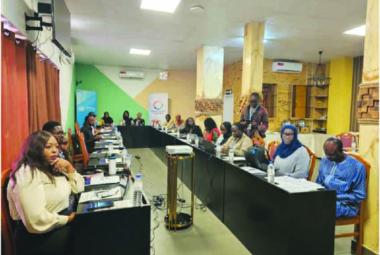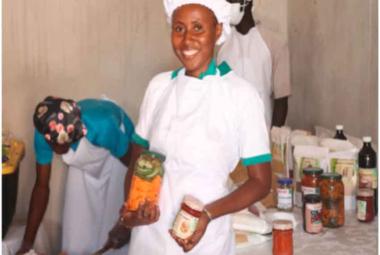By Kumba Leigh
Antimicrobial Resistance (AMR) is said to be one of the most urgent-yet-underreported public health threats, responsible for millions of deaths worldwide. It is driven by the misuse of antimicrobials such as antibiotics in human, animals and plants. The Africa CDC 2024 report on Antimicrobial Resistance indicated that an estimated 700,000 people die annually from drug-resistant infections globally. In this piece we find out about the state of antimicrobial resistance in Africa and The Gambia in particular, and its impacts, through expertise views, and explanations. Antimicrobials – including antibiotics, antivirals, antifungals, and antiparasitics are medicines used to prevent and treat infectious diseases in humans, animals and plants. Experts say AMR occurs when bacteria, viruses, fungi and parasites no longer respond to antimicrobial medicines. It is said to threaten the effective prevention and treatment of an ever-increasing range of infections caused by bacteria, parasites, viruses and fungi.
The Centre for Disease Control and Prevention reports that antibiotics and antifungals save lives, but the manner of use can contribute to the development of resistant germs. The ARM is said to accelerate when the presence of antibiotics and antifungals pressure bacteria and fungi to adapt. The consumption of low quality drugs, a phenomenon believed to be rampant in The Gambia is also said to cause AMR. AMR occurs when microorganisms like bacteria, viruses, fungi and parasites develop resistance to antimicrobial drugs, a process hastened by human behaviors such as the misuse and overuse of these drugs in healthcare, agriculture and food systems. This renders antibiotics and other antimicrobials less effective, causing treatment failures, increased disease spread, severe illness, disability and higher mortality rates.
How? Antibiotics and antifungals kill some germs that cause infections. They can also kill helpful germs that protect our body from infection. The antimicrobial-resistant germs survive and multiply. Thus, surviving germs have resistance traits in their DNA that can spread to other germs. Also, germs can develop defense strategies against antibiotics and antifungal called resistance mechanisms. DNA tells the germ how to make specific proteins, which determine the germ’s resistance mechanisms. Bacteria and fungi can carry genes for many types of resistance. When already hard-to-treat germs have the right combination of resistance mechanisms, it can make all antibiotics or antifungals ineffective, resulting in untreatable infections. Alarmingly, antimicrobial-resistant germs can share their resistance mechanisms with other germs that have not been exposed to antibiotics or antifungals.
The situation in Africa Africa CDC’s recent report findings, dated on 15 August, 2024 on AMR, surveillance and disease intelligence on the Central Africa, Eastern Africa, Northern Africa, Southern Africa and Western Africa has indicated that the likelihood of falling ill or dying from diseases that resist treatment has escalated in Africa, with children and other vulnerable groups being most at risk. “The continent faces the highest mortality rate from antimicrobial resistance (AMR), with 27.3 deaths per 100,000—exceeding the combined death toll from HIV-AIDS, tuberculosis and malaria,” stated the ‘African Union Landmark Report’ recently launched at Africa CDC headquarters. Africa bears a significant burden of infectious diseases, accounting for approximately 95% of malaria deaths, 70% of people living with HIV, and 25% of TB deaths globally, said the AMR report, 2024.
“We must not ignore this silent threat that disproportionately impacts the most vulnerable among us,” said Africa CDC Deputy Director General, Dr Raji Tajudeen. Dr Banard Appiah, a Pharmacist and Public Science Expert, Syracuse University, expressed concern that some medicines given to patients no longer work due to the fact that most people are reluctant to adhere to prescriptions of their medical reports. “Sometimes is due to the scarcity of the specific medicine in store, or medicine companies don’t have the right quantity. This is what we call ‘Active Ingredients’ and overtime the germs become resistant, therefore leading to a serious problem,” he explained.
The challenges Despite the estimated USD2-6 billion needed annually for an effective AMR response across Africa, current funding is only a tenth of that allocated to other major diseases, according to experts. This underfunding makes AMR a significant barrier to sustainable development, hindering progress toward the Sustainable Development Goals (SDGs) and the African Union’s Agenda 2063. Health advocates also recently initiated discussions on a roadmap and targets to advance Africa’s battle against AMR. The outcomes are expected to inform and impact the recently concluded United Nations General Assembly High-Level Meeting in September—a crucial platform for global action on this escalating crisis.
The Gambia’s case Haruna S. Jallow, is Principal Lab Scientist at the National Public Health Laboratory Services, Ministry of Health. He said despite Gambia having gone far in terms of response to Antimicrobial Resistance – as far as coming up with the National Action Plan against AMR, the country does not have an official documentation on AMR. “As a country, we are a bit behind in terms of diagnostics; especially on the microbiology aspect. There is need to do more investment in the microbiology labs and microbiology testing lab in every region in the country, and provide them with the necessary skills and knowledge”. He said other available labs - for HIV, TB, and malaria - are fully functional because they are sponsored by the Global Fund and other projects; while the microbiology lab depends on government supplies, which most of the time is short of reagents, and antimicrobial disc that help to determine AMR in The Gambia. “This helps to support treatment, evaluate and monitor AMR cases in the country,” he explained.
On the inadequacies, Mr Jallow revealed that there is a global glass platform, where every country submits its AMR data and The Gambia is colored yellow. “This means we just answer questionnaires, but we do not have a country data on AMR or statistics that indicate our AMR status. We only have a representative which could be obtained from EFSTH or MRC,” he added. He went on: “We can get a data from either EFSTH or MRC but the question here is that, is data realistic? Assessing AMR is not only limited to testing, but also we need a platform to be able to input our country data, so that we are able to present a country data on AMR.” He revealed that The Gambia has very few functional microbiology labs in the country, found only at Edward Francis Small Teaching Hospital, Kanifing Hospital, and Bwiam Hospital, while the likes of Bansang, Farafenni and Basse are not functioning. The rest do not have.
“Although we have trained some health personnel on “who-net”, which is a computer platform where AMR lab technicians can submit their AMR data, yet this is in pieces, and requires desktop computers in labs, to ensure recordings take place and are collated to make a country data,” he alluded. The Principal Lab Scientist, lamented the fact that the country is losing most of its antibiotics like Septrin and ampicillin due to resistance. He feared about the imminence of outbreaks amidst the fact that most of the bacteria discovered are resistant to treatment. He said in the recently concluded UN meeting countries are tasked to play a role in AMR reports, because it is realized that millions of people are being lost, and many from arbitrary death due to AMR. He pointed out that without a laboratory data to ascertain the cause of death it will be difficult to label and identify the cause.
The Strategy Mr Jallow said they are using the ‘One Health Approach’ which entails an established team of responders, comprising of stakeholders from ministries like Fisheries, Agriculture, and NARI, Food Safety and Quality Authority, Health Promotion, who are engaged in awareness creation. He revealed that through the help of WHO, they have developed a national action plan, and trained personnel on tools and the knowledge of strengthening laboratory areas to combat AMR, as well as investigations skills to determine patients that are resistant to a particular antibiotics; and the clinicians on the choice of drugs to treat the patients. Mr Jallow expressed concern about the increase in the number of pharmacies in the country. He said some of them just prescribe drugs without detail information, as well as poor storage, and the misuse and misinterpretation of drugs to patients. The estimated 700,000 people dying annually from drug-resistant infections globally, according to the Africa CDC 2024 report on Antimicrobial Resistance, is projected to reach 10 million by 2050, with Africa accounting for 4.5 million, unless timely intervention is made.







